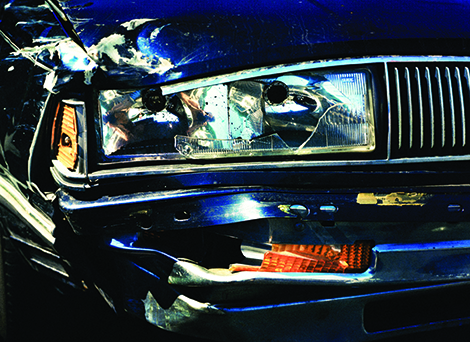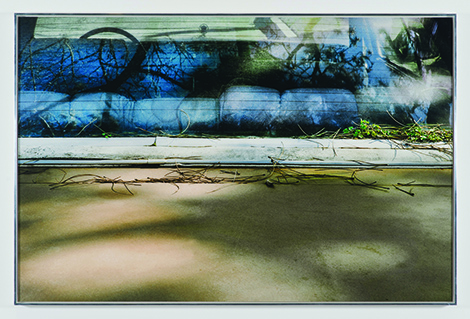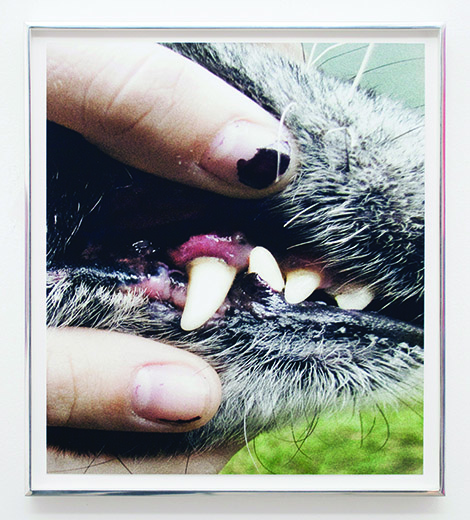The catastrophic intersection of the man-made or engineered environment with nature may be the great subject of 21st century art. As the title of her show implies, Liza Ryan places visual brackets around our notions of boundary—of separation, protection or insulation from this catastrophe. In most of these photographic prints, the subject is a fragmentary view of an automobile exterior or interior (or interior view taken from the exterior). The frame is, in a sense, nature itself—the “natural” setting viewed peripherally or through the translucence of glass layers, a filtered blur, or the sutured, alternately transparent or reflective surfaces of shattered glass, or polished metal.
Guide (2014) takes its title from the brand of a headlight assembly, the mark visible beneath its broken plastic cover, its silvery wales and ridges echoing the ribbing of the car’s grille. Despite the fragmentary manufactured perfection, nothing remains that does not suffer an ‘earth-change.’ It’s chaos cross-sectioned: shattered glass, twisted metal, cracked plastic; the exposed primer on heavy metal now crumpled like paper; a smear of acid yellow paint or putty that seems vaguely organic, and was—before the extractions and processing that produced everything in this picture. Visible in the same assembly we can make out a slice of conventional landscape, with a slightly jagged horizon line of man-made structures against the sky—the kind of panoramic landscape we might see in a souvenir postcard.

Liza Ryan, Guide, 2014, Courtesy of the artist and Kayne Griffin Corcoran, Los Angeles, Photo credit: Brian Forrest
They’re all souvenirs—not the bullet that made a parachute netting of the glass in Wind(shield) bullet (2014), but its shadow on the glove box, with the reflected bullet hole as a bright absence at its center; and the silk scarf just beneath the glass, unfurled like an elongated rose petal, with faint red or pink marks on the glass that hint at a distant blood spatter. The structure limned in the haze outside might just as well be out of a nightmare. In their materiality, they invite us to contemplate oblivion.

Liza Ryan, Clover, 2014, Courtesy of the artist and Kayne Griffin Corcoran, Los Angeles, Photo credit: Brian Forrest
The sound and fury of nature in its violence fades here to something coolly reconstructed. In Wind(shield) hail (2014), the ‘scar tissue’ of the fractured safety glass divides the frame into zones of dark and light, with the lower right portion portending an oncoming storm across a horizon, and the upper left portion revealing a clearing sky bright with clouds. Human artifacts seem an almost insulting intrusion on an organic exchange. The quiet copulations of Clover and 300 (2014) give way to something approaching the elegiac in Blue Bleed (2013) in which a polished car hood littered with jacaranda blossoms becomes a sapphire reflecting pool for the trees looming directly overhead and reflected in the windshield.
As if to underscore the contingent ‘tooth-and-claw’ aspect of these intersections with nature, Ryan exposes a dog’s incisor between two human fingers in Dogtooth (2014). But the implied violence and decay abide quietly with their aftermath in these largely meditative pictures. The absurdity of our “Fabu-lash” vanities will fade soon enough beneath their mute absorption into the earth.


